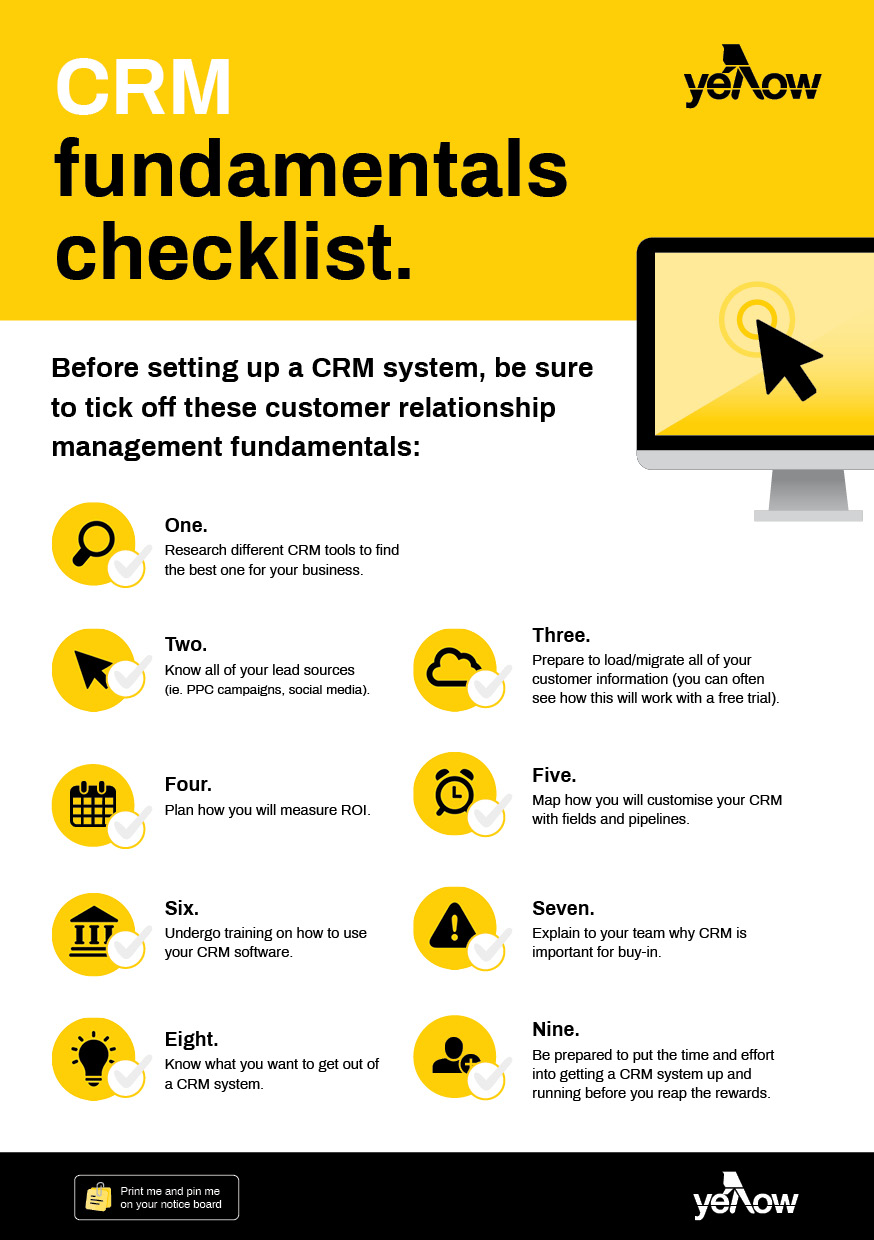If your business has customers, it needs a customer relationship management (CRM) system to track, manage, and optimise every interaction.
Many businesses start with a simple spreadsheet, but as they grow, a CRM becomes essential for managing sales, marketing and customer engagement in one place. Today’s CRMs go beyond storing contact details—they use automation and AI-driven insights to improve efficiency, increase revenue and strengthen customer loyalty.
Here are five of the biggest benefits of CRM software and how it can transform your business:
1. Retain and re-engage customers throughout the customer journey with AI-powered insights.
You’ve invested time and money to win a customer—don’t let that effort go to waste.
How a CRM system helps:
- Identify inactive customers and use segmentation to send automated re-engagement campaigns tailored to their purchase history and preferences
- Use AI-powered churn prediction to flag customers at risk of leaving before they disengage.
💡 Tip: The fewer steps between a customer and their next purchase, the better. Automating re-engagement keeps your brand top-of-mind without relying on manual outreach.
RELATED: What is a CRM system and how can you use it?
2. Identify and prioritise high-intent leads with AI and automation.
Not all leads are the same. Some are just browsing, while others are ready to buy—but how do you know which is which?
How a CRM system helps:
- Track lead activity across multiple channels (email, website visits, social media, chat interactions)
- Use AI lead scoring to rank prospects based on engagement levels
- Automate follow-ups to keep warm leads engaged until they’re ready to convert.
💡 Tip: The faster you respond to a lead, the more likely they are to choose your business. With a CRM system, you can automate this process and strike while the interest is high.
RELATED: The benefits of automation for small business.
3. Invest in the right marketing channels with data-driven insights.
Throwing money at random marketing efforts can be a waste. A CRM system shows where your best customers are coming from so you can spend smarter.
How a CRM system helps:
- Track which marketing channels drive the most valuable leads
- Integrate with Google, Facebook and TikTok Ads to optimise campaigns based on real sales data.
- Use predictive analytics to adjust ad spend before campaigns under-perform.
💡 Tip: Stop guessing where your customers come from. Use a CRM system with marketing analytics to measure real ROI and maximise your marketing dollars.
RELATED: You’ve created your CRM database. Now what?
4. Drive more revenue with automated up-selling and cross-selling.
Most businesses focus on getting new customers—but selling more to existing customers is easier and more profitable.
How a CRM system helps:
- AI-powered product recommendations suggest the best up-sells and cross-sells
- Automate follow-up emails with complementary product or service suggestions
- Track customer purchase history to personalise offers.
💡 Tip: Use CRM automation to offer up-sells at the right time—when a customer is already buying something.
5. Forecast sales and manage inventory with predictive analytics.
Instead of guessing how much stock you need or which services will be in demand, a CRM analyses past sales trends to predict future needs.
How a CRM system helps:
- Forecast demand based on seasonal trends and historical data
- Automate inventory alerts to prevent overstocking or running out of key items
- Adjust marketing and sales strategies based on data-driven projections.
💡 Tip: The best business decisions are data-driven. A CRM helps you plan ahead instead of just reacting.
Centralised data management with CRM software.
Single view of the customer: why it matters.
One of the biggest benefits of CRM software is its ability to provide a single view of the customer. This means all customer data—contact details, purchase history, past conversations and engagement records—is stored in one centralised system.
Instead of scattered information across different platforms, businesses can access a complete and up-to-date customer profile from one dashboard.
How a CRM system’s single customer view improves business performance.
- Personalised customer interactions – Sales and support teams can instantly access previous purchases and interactions, making every conversation more relevant and tailored
- Consistent service across teams – Whether a customer calls, emails or chats on social media, every department has the same updated information
- Stronger sales & marketing alignment – Sales can track leads more efficiently, while marketing can segment audiences and send personalised campaigns based on customer behavior
- Faster and more efficient support – Customers don’t have to repeat their history, leading to quicker resolutions and higher satisfaction
- Smarter decision-making – With all customer data in one place, businesses can identify trends, opportunities, and areas for improvement.
How Thryv helps businesses streamline CRM software and automation.
For businesses looking for a complete CRM solution, Thryv offers an all-in-one platform that integrates customer management, marketing, quoting, invoicing, and automation.
Why businesses choose Thryv:
- AI-powered customer insights help businesses engage the right leads at the right time
- Built-in marketing tools optimise campaigns for maximum ROI
- Seamless quoting and invoicing automates financial workflows and improves cash flow
- Multi-channel tracking ensures businesses never lose touch with a lead or customer
- Automated tasks and valuable insights provided by Thryv help improve customer service by streamlining operations and enhancing communication with customers.
Want to learn more? Explore Thryv’s CRM features here.
Who in your team will benefit from a CRM system?
A CRM system isn’t just for sales—it helps multiple teams work more efficiently by providing a centralised view of customer data and automating key tasks.
A CRM system benefits multiple teams across a business: Sales reps can prioritise high-intent leads and automate follow-ups; marketing teams can optimise campaigns and audience segmentation; and customer service teams can provide faster, more personalised support.
RELATED: CRM-based appointment scheduling: Streamline your bookings and boost efficiency.
FAQs about CRM systems.
Why should you use a CRM?
A CRM is great at making it easier for managing customer interactions, leads, sales, and marketing campaigns in one place. It streamlines operations, improves efficiency, and helps businesses build stronger customer relationships.
What is the greatest advantage of a CRM system? <H3>
The biggest advantage of a CRM is automation—it reduces manual work by automating lead follow-ups, marketing campaigns, invoicing, and customer communications, allowing businesses to focus on growth and service rather than admin tasks.
Additionally, automation in CRM systems streamlines the sales process, making it more efficient by managing leads and providing insights that help sales teams adapt their strategies and improve customer segmentation.
Is CRM really necessary?
If your business deals with multiple customers, leads or sales processes, a CRM is essential for staying organised, improving response times, managing the sales funnel and boosting conversions. Even small businesses can benefit by saving time and scaling efficiently.
What problems does a CRM system solve?
A CRM system helps solve:
- Lost leads and missed follow-ups – Automates reminders and customer interactions
- Inefficient sales processes – Provides data-driven insights to improve conversion rates
- Poor customer retention – Helps businesses engage and retain customers with automated communication
- Scattered business data – Keeps customer records, sales data and marketing insights in one place.
Why every business needs a CRM system.
The way businesses manage customer relationships is evolving fast. Without a CRM system, you’re wasting time on manual tasks, missing out on sales and struggling to track customer interactions.
With Thryv, reach a higher customer satisfaction with automation, AI-driven insights and multi-channel tracking—all in one powerful platform. Take control of your customer relationships and set your business up for long-term success.

